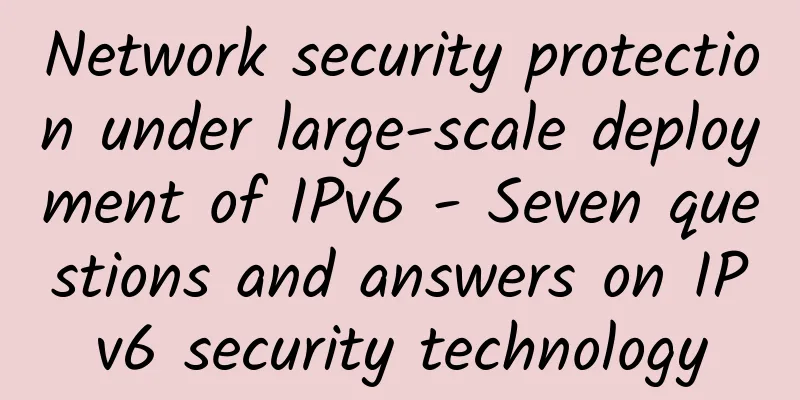The biggest risk of 5G networks

|
The fifth generation (5G) network has the potential to integrate technology into people's lives and business environments. This revolutionary technology can provide the bandwidth required for 50 billion smart devices, leading us to a new world where all computing power can be connected. However, such disruptive technology not only opens up many opportunities, but also brings unpredictable risks. As speed, connectivity and responsiveness continue to expand, more sensors and devices will be deployed in cities, homes, vehicles and around us, generating data at an unprecedented rate. In addition to being related to personal activities and physical and mental conditions, these technologies also provide new experiences in terms of convenience, entertainment and productivity; this will prompt all sectors to pay more attention to issues such as defense against intrusion, personal safety and privacy.
The fifth generation of networks represents an important technology that will enable the next wave of computing devices to be connected to the Internet, benefiting a wide range of users. The upcoming 5G network will significantly surpass the existing 4G LTE mobile network, increasing data transmission rates by 30 or even 100 times, thereby reducing transmission delays for quick response, and most importantly, 5G will be able to connect billions of devices in the next few years, including cars, smart clothing, ingestible medical sensors, home appliances, drones, traffic signs, street lights, industrial equipment and many other items that will be connected and share data. 5G will bring computing to a more personalized level, including wearable devices, embedded sensors, smart cars, home automation, personalized medical and monitoring, and environmental sensing entertainment devices, which will connect various groups and achieve a wonderful life. Various devices will not only be easier to operate, but will also be able to reliably share information and work together to enhance convenience, productivity, safety, health, and interaction between friends and family. However, such a powerful tool may also be used by people with bad intentions or unethical people. ▲Self-driving cars are taking to the road one after another, which can prevent collisions and shorten driving time. We must prevent technology, data, and privacy from falling into the hands of malicious people. The value of 5G networks and devices must be built into the dimensions of security, trust, and privacy. We should not only embrace technology because it greatly improves the way we communicate and interact with the world, but also establish various protection mechanisms for systems and users. As devices become smarter and more powerful, we trust them to perform real-world tasks, which means giving up a certain amount of control. In most cases, this is a good thing, bringing absolute benefits, increased productivity, and improved safety. It is much safer to let a smart car help you park on the side of the road than to park yourself in a panic. People who are not good at parking always get in the way of cars coming from behind, which makes them more nervous, often causing minor accidents and increasing insurance premiums. Let the car receive the driver's parking instructions, measure the space, quickly control the vehicle, and drive it safely into the parking space. This magical magic completely beats the constant circling to find a parking space that is easier to park yourself. However, to enjoy such advantages, it is necessary to ensure that such smart cars can immediately judge the current environment. When the driver wants to squeeze into a parking space, it is acceptable to drive slowly, but if the car is driving at high speed on the road and a malicious hacker wants to control the car, it will endanger the safety of passengers. As 5G rapidly promotes the development of networking and related functions, various risks and necessary safety protections must not be ignored. 1. The biggest risk of 5G networks For the emerging IoT devices, the biggest risks currently faced are security and privacy. Some people believe that industrial control hides the biggest risks, but I question this view. Industrial Control Systems (ICS) have long been widely used in power plants, sewage treatment plants and chemical plants. These systems have gradually been connected to the Internet. ICS operators have not only identified various risks long ago, but also realized that they have been attacked for many years. To prevent intrusion, they try to limit the scope of these systems' exposure to the Internet, and sometimes even deliberately do not upgrade their networking functions. Many smart devices in ICS plants can be hacked in theory, but in practice, hackers usually target systems with more sophisticated control mechanisms such as servers and personal computers. 5G will be put into operation between 2018 and 2020. According to analysis, the industries with the highest risk will be consumer devices, including transportation, medical care and drones. These industries will be the most frequently reviewed for protection, privacy and security issues. 2. Face the risks behind the advantages The following three scenarios provide examples of the risks associated with various advantages. 1. Context: Cars/Self-driving cars The next generation of cars and mass transit vehicles will be able to use 5G networks to communicate with other vehicles and road sensors to prevent collisions, shorten travel times and improve fuel efficiency. But if these vehicles fall into the hands of malicious attackers, they could slow down traffic or even cause serious accidents. 2. Context: Health care Medical monitors can improve health, warn of critical conditions, help doctors fine-tune medication dosages, and help researchers find patterns among populations to improve treatments for the most serious chronic diseases. However, such capabilities can also be abused, with privacy violations, data manipulation and counterproductive effects, exposing patients to serious consequences. 3. Scenario: Drone Drones are being rapidly adopted by all sectors to expand the range of services and functions. Drones can quickly deliver medical resources across difficult terrain, assist in the detection and combating of forest fires, survey various harmful environments, perform military missions in dangerous areas, enable artists to have innovative expression methods, and become the vehicle of the future of package delivery services. However, these drones can also pose a danger to passenger planes during takeoff and landing, their ability to extinguish fires could become a weapon for terrorists, they could endanger people participating in protests, they could be used for drug smuggling, and they could invade the privacy of individuals’ homes. 3. Strive to protect 5G equipment Users, devices, software, networks, and backend infrastructure should all take responsibility to promote the security of 5G devices. The problems faced by all parties are similar to the challenges currently facing the Internet, but on a much larger scale.
▲Drones can extend the coverage of various services and functions, but they also come with risks in terms of security and privacy. Newly emerging IoT devices present a whole new challenge. Unlike personal computers, servers, and smartphones, these IoT devices cannot defend themselves, and most of them may lack sufficient computing power and speed to run sophisticated multi-functional security solutions. Therefore, the focus is on other aspects, such as hardware, network, application authentication, and back-end infrastructure, to make up for these deficiencies. 4. Start building trust as the foundation of 5G It is critical that technology leaders work together to develop robust standards that include more robust security mechanisms, enhanced privacy, tighter controls for life-critical systems, etc. Failure to proactively maintain security will result in loss of customer support and adoption, undermining the value proposition of IoT and 5G. Trust is extremely important. Security must be built into 5G standards and be part of the foundation, especially considering the possible applications of the Internet of Things. In terms of privacy, in order to reduce the operational burden on users, default anonymity and anonymity options should be considered when designing products and software. Systems that could pose a threat to life safety should have higher levels of security, oversight, and control. As users adopt technologies such as autonomous transportation and medical management systems, trust levels should increase for a variety of risks. The industry has developed to the point where security mechanisms are fully integrated into the entire architecture, rather than being an afterthought. Technology leaders must now work together to establish a root of trust for 5G’s foundation and application levels. Consumers should also fulfill their responsibilities and express their demand for trust. Consumers’ demand for security will prompt suppliers to invest in launching secure products to maintain competitiveness and service quality. V. Maintaining Security, Protection, and Privacy Technological innovation and impact must cover three areas to support 5G protection, security, and privacy: 1. Develop the right architecture and platform to embed security and trust into 5G connected devices and the backend infrastructure that will handle the massive amounts of data. 2. Facilitate industry collaboration, establish sound frameworks and technical standards, and promote strong protection, security controls, and privacy principles. Intel’s automotive team is a good example, which has made many security recommendations and organized industry alliances to promote various best practices. 3. Provide best-in-class security software solutions to help devices and applications resist various rapidly evolving security threats. The high flexibility of the software can cope with various new threats and respond to the risk tolerance of the device. These solutions can be adjusted to run in a controlled computing environment. In addition to supporting smaller or fixed-function devices, they can also be used to manage infrastructure and monitor entire clusters of systems. In summary, 5G is coming, connecting more and smaller devices, and bringing major progress to the electronics industry system. This will not only open up many unforeseen opportunities, but also bring many risks. In order to profit from it and minimize the risks, technology leaders and security professionals must now work together to lay a solid foundation and continue to promote the development of 5G networks in terms of security, privacy, and defense. |
<<: Fenghuo will present FitOS6.0 cloud operating system at 2017 OpenStack Sydney Summit
>>: 5G backhaul will become the next growth point in the field of optical communications
Recommend
Hostwinds: VPS/cloud server from $4.99/month, Seattle/Dallas/Netherlands data center, supports Alipay
Hostwinds is a long-established foreign hosting c...
Kubernetes Gateway API v1.1 Interpretation, do you understand it?
A few days ago, the K8s Network SIG released the ...
#已跑路#Limewave adds 15% off on AMD Ryzen series, 2G memory package 1Gbps unlimited traffic starts at $5.95/month
【Attention】This merchant has run away!!! Limewave...
2021 China Internet Haha List 2: Top Ten Events
In 2021, the Internet industry has emerged with m...
SpringCloud Alibaba Microservices Practice: Gateway Authorization VS Microservices Authorization
[[386274]] This article is reprinted from the WeC...
The final of the Maker Beijing 2020 Kunpeng Application Innovation Competition is about to begin. Who will win the championship?
On August 20, 2020, the Maker Beijing 2020 Kunpen...
One year later than expected! The global microwave transmission market is expected to enter a multi-year growth period in 2021
Recently, Jimmy Yu, vice president and analyst at...
Ruijie Networks: Not only a light chaser, but also a light maker for Ethernet all-optical networks
With the rapid development of information technol...
With the launch of 5G and Wi-Fi 6, where will wireless network products go?
Today, topics about 5G and Wi-Fi are endless, and...
Interesting explanation of bearer: PTN and IPRAN in one article
The "old-fashioned" old boss—SDH The tr...
Omdia Observation: TIP open core network plan is progressing slowly
According to the latest report from market resear...
Xiaoyu Yilian's full range of new products are officially released to ignite the nuclear fusion of the audio and video conferencing industry
On August 2, the 2017 Xiaoyu Yilian E=mc² new pro...
DogYun New Year Promotion: 30% off on Elastic Cloud, 20% off on Classic Cloud, 100 yuan off for standalone server, free next month, top up 100 yuan and get 10 yuan free
DogYun announced yesterday its promotion during t...
HostYun UK London AS9929 line VPS host 10% discount monthly payment starting from 22.5 yuan, native IP
Those who are interested in UK VPS can pay attent...
AkkoCloud: UK CN2 GIA/Germany CN2 GIA/US CN2 GIA high bandwidth VPS quarterly payment starts from 99 yuan
We know that the CN2 GIA line is one of the relat...









